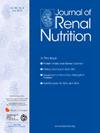Evaluation of Amino Acid Kinetics During Low-Dose Continuous Renal Replacement Therapy in Patients With Acute Kidney Injury: A Prospective Single-Center Study
IF 3.2
3区 医学
Q2 NUTRITION & DIETETICS
引用次数: 0
Abstract
Objective
Amino acid and protein loss during continuous renal replacement therapy has been proposed to contribute to protein-energy wasting in patients with acute kidney injury (AKI); however, the actual amount removed remains unclear. We investigated the loss of amino acids and proteins in the filtrate during continuous renal replacement therapy in patients who did not receive nutritional supplementation.
Methods
A total of 19 patients with AKI who received low-dose continuous venovenous hemofiltration (CVVH) were included. Blood samples were collected before CVVH initiation and at 30, 60, 120, and 240 minutes thereafter, and a filtrate sample was collected at 240 minutes. Changes in blood amino acid concentrations during 240-minute CVVH sessions were measured. The amino acid and protein concentrations in the filtrate were determined at the end of the 240-minute CVVH session, and the amounts of amino acids and proteins lost during 240-minute CVVH were calculated.
Results
The median total amino acid blood concentrations did not decrease and were near the lower limits of the reference ranges. The median concentrations of 3-methyl histidine, a marker of skeletal muscle catabolism, were above the upper limits of the reference ranges throughout the CVVH session. The median total amino acidloss during the 240-minute CVVH session was 0.95 g. In 10 patients with detectable proteins in the filtrate, the median protein loss was 2.52 g.
Conclusion
These results suggest that optimal nutritional management in patients with AKI who receive CVVH should take into account amino acid and protein loss and hypercatabolism.
急性肾损伤患者低剂量连续肾替代治疗期间氨基酸动力学的评估:一项前瞻性单中心研究。
目的:在持续肾替代治疗(CRRT)期间氨基酸和蛋白质的损失被认为是急性肾损伤(AKI)患者蛋白质能量浪费(PEW)的原因之一;然而,实际的撤资数额仍不清楚。我们研究了没有接受营养补充的患者在CRRT期间滤液中氨基酸和蛋白质的损失。方法:选取19例接受低剂量连续静脉-静脉血液滤过(CVVH)治疗的AKI患者。CVVH起始前和起始后30、60、120、240分钟采集血样,240分钟采集滤液样本。测量240分钟CVVH期间血液氨基酸浓度的变化。在240分钟CVVH结束时测定滤液中的氨基酸和蛋白质浓度,并计算240分钟CVVH期间氨基酸和蛋白质的损失量。结果:总氨基酸(TAA)血药浓度中位数未下降,接近参考范围下限。3-甲基组氨酸(骨骼肌分解代谢的标志物)的中位浓度在整个CVVH期间都高于参考范围的上限。在240分钟的CVVH期间,TAA损失的中位数为0.95 g。在滤液中检测到蛋白质的10例患者中,平均蛋白质损失为2.52 g。结论:这些结果表明,接受CVVH治疗的AKI患者的最佳营养管理应考虑氨基酸和蛋白质的损失以及高分解代谢。
本文章由计算机程序翻译,如有差异,请以英文原文为准。
求助全文
约1分钟内获得全文
求助全文
来源期刊

Journal of Renal Nutrition
医学-泌尿学与肾脏学
CiteScore
5.70
自引率
12.50%
发文量
146
审稿时长
6.7 weeks
期刊介绍:
The Journal of Renal Nutrition is devoted exclusively to renal nutrition science and renal dietetics. Its content is appropriate for nutritionists, physicians and researchers working in nephrology. Each issue contains a state-of-the-art review, original research, articles on the clinical management and education of patients, a current literature review, and nutritional analysis of food products that have clinical relevance.
 求助内容:
求助内容: 应助结果提醒方式:
应助结果提醒方式:


